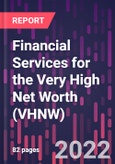The financial services industry always rises to the task of profitably serving the needs of the most affluent Americans. The industry’s advisors and wealth managers have pivoted their strategies as they respond to the mutability of wealth and the wealthy. Over time, wealth managers have seen every characteristic of wealth management change; from the magnitude of that wealth (today, the 10 richest Americans own 288% more of the world’s wealth than in 1960) to its origins in entrepreneurship rather than inheritance and to the holding of wealth in a sophisticated array of investment vehicles rather than bank trusts.
This new report, “Financial Services for the Very High Net Worth (VHNW)” analyzes each segment of the affluent market (high-net-worth, very high-net-worth and ultra high-net-worth) and its relationship with the financial services industry. The report offers a particular focus on the very high-net-worth (truly affluent) segment.
Two concurrent trends have left a gap in market research into the affluent market: The rise of defined contribution plans and the increasing wealth of the ultra high-net-worth. The rise of defined contribution retirement plans (e.g., 401(k)s) shifted retirement savings obligations from employers and their pension plans to employees themselves. Each time an employee changes jobs or retires, the balance in their retirement savings account moves with them, shifting over $500 billion a year from 401(k)s to traditional IRAs. This “new” money funneling into traditional financial services companies offering rollover IRA accounts created an industry-wide focus on the mass affluent and high-net-worth markets ($500,000 to $5 million in investable assets).
The ultra high-net-worth individual, with $30 million or more in investable assets, has always beguiled the money management industry. The wealthiest Americans, with their multi-generational wealth, corporations and foundations and complex financial and estate planning strategies have generated enormous fees for financial services firms and as the cohort’s control of American wealth continues to increase (from 29% of household net worth in 2007 to 32% in 2022), the competition to serve the top 300,000 of the wealthiest American households only intensifies.
This new research has a particular focus on the group of wealthy individuals who comprise the very high-net-worth segment (those with $5 million to $30 million in net worth). With the financial services industry focused on the wealth directed their way through rollover IRAs and their traditional focus on the ultra high-net-worth market, the group of 1.8 million households, that are all in the top 1% and top 2% of households by net worth, have needed a fresh analysis to understand who is in the very high-net-worth category, what these households own and how their assets are managed, as well as the group’s demographics and their lifestyle preferences.
The publisher estimates that the truly affluent generate, at a minimum, $568.9 billion in asset management and other financial transaction fees for the financial services industry.
Table of Contents
Companies Mentioned
- Morgan Stanley
- Bank of America
- J.P. Morgan
- Goldman Sachs
- Credit Suisse








